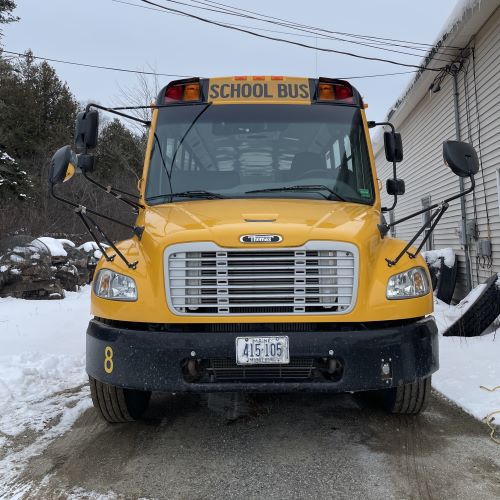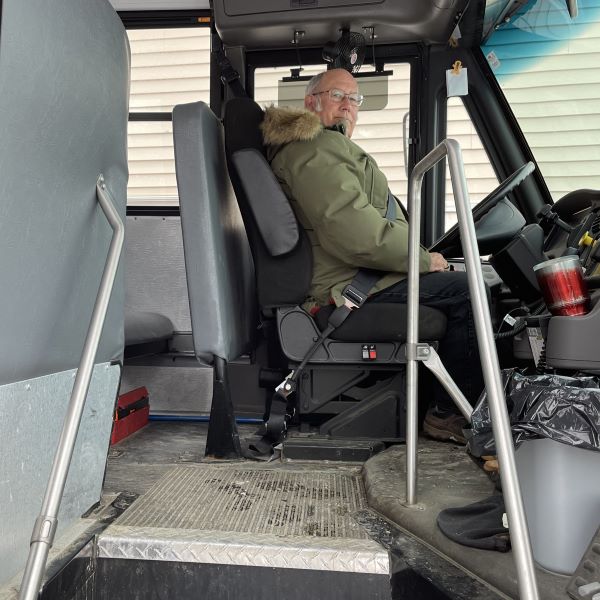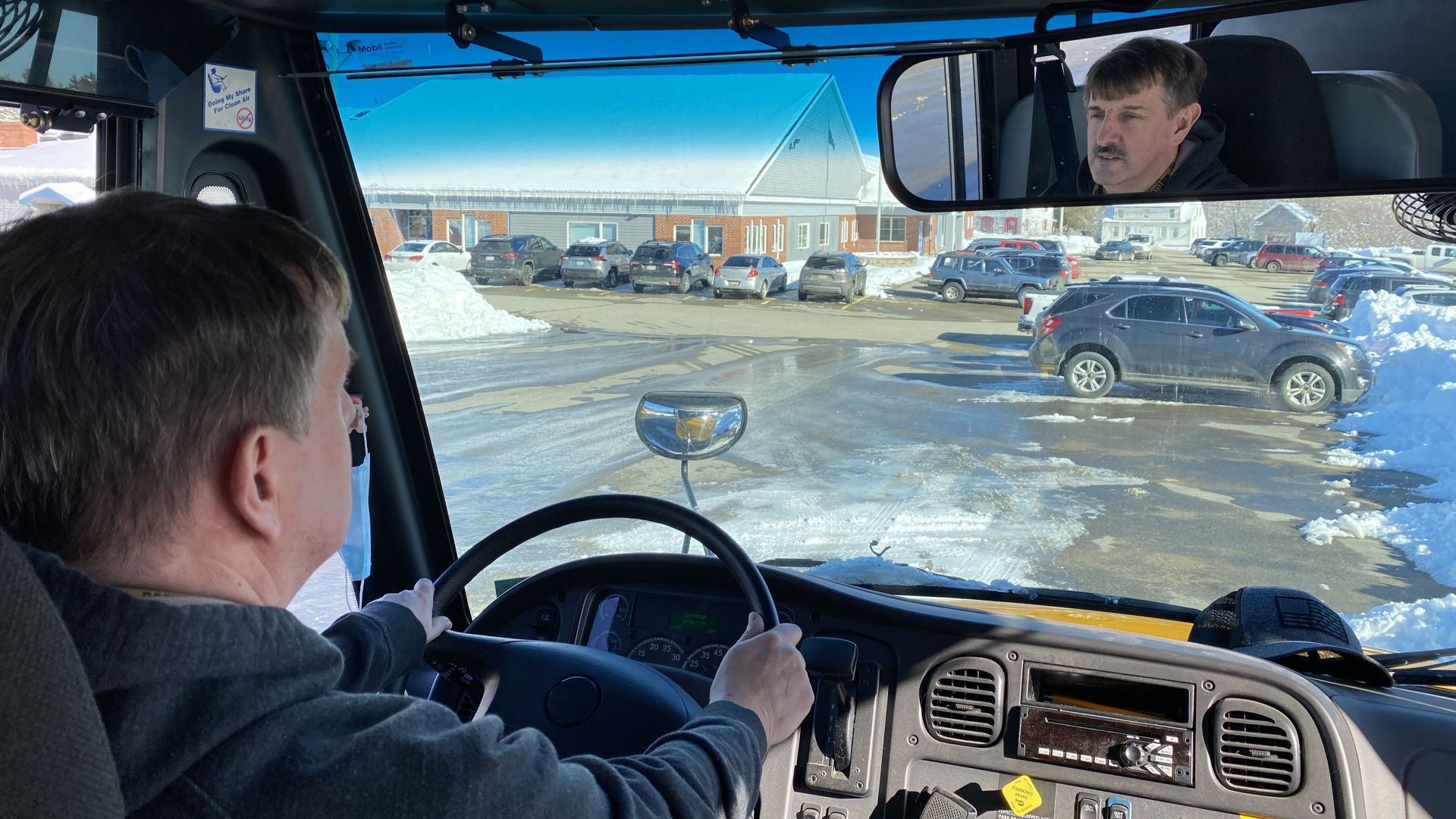The shortage of school bus drivers has reached a crisis point in Washington County, with school administrators resorting to extreme measures — including driving the bus themselves.
“When I open the bus door, they look up and see me and say, ‘Oh! Mr. Maker is driving the bus today,’ ” said Tony Maker, principal of Elm Street School in East Machias. “I say, yeah, you never know who you’re gonna see driving the bus.”
With one of the elementary school’s two drivers out recovering from surgery and a scant supply of substitutes countywide, Maker took the drastic step last fall of signing up to obtain his Class B Commercial Driver’s License (CDL) and school bus driver endorsement. After two weeks of rigorous training and testing, Maker received his license and endorsement in January, and is now often seen behind the wheel as well as behind his desk.
The school bus driver shortage has been a chronic problem for Washington County schools, as well as across the state and country. In Maine, larger population centers such as Portland even struggle to staff buses. In Massachusetts two years ago, the National Guard was called in to transport students. Although nowhere near that dire in Washington County — at least not yet — according to officials from several schools, the problem has gotten much worse over the last two years.
Schools are typically shy at least one bus driver every day, with no backup. Making matters worse, most of the county’s school drivers are at or beyond retirement age. Coupled with meager compensation and sparse, split hours, it’s hard to entice new drivers, so the ranks keep dwindling. The absence of drivers is causing doubled-up, delayed or suspended bus routes; later school start times; canceled sports and after-school activities; and parents frequently enlisted to transport their children.
Patti Morgan of Columbia Falls and her husband have two sons, Ryker, a third-grader at D.W. Merritt Elementary in Milbridge, and Dracen, a ninth-grader who attends Narraguagus High in Harrington, both part of School District 37. Morgan said their morning bus route was canceled for almost a month last year, leaving her and her husband to drive the boys themselves.
“We both work from home but driving them takes about 40 to 50 minutes of our morning because the schools are on opposite ends of town. It’s a lot of gas too,” Morgan said. “We have a bus service for the school and I’d like to utilize that.”
Although the morning bus service has been restored, Morgan said there are still last-minute cancellations, usually discovered on the district’s Facebook page. Ron Ramsay, the district superintendent, said the scarcity of drivers is only one symptom of the overall labor shortage that’s putting a strain on the entire school system, with shortages from drivers and custodians to teachers and administrators.

The district recently upped the starting pay for bus drivers from $14 to $21 per hour, with pay for existing drivers topping out around $24 per hour. Still, CDL Class B drivers can get much more money driving construction vehicles. Although raising school bus driver pay helped some, Ramsay acknowledges parents are still being called on as surrogate drivers far too often.
“We’ve got way more parents transporting than we normally would have,” Ramsay said. “I think that’s frustrating to some parents so they just say, ‘heck, I’m not going to mess with it.’ They’ve gotten very used to doing it and haven’t switched back.”
Ramsay said because the situation fluctuates, it’s difficult to say how many students are affected. He estimated that of the district’s roughly 660 students, the number could be as high as a couple of hundred being transported by parents.
Farther east in the county, the Machias Bay Area School System, A.O.S. 96, is also calling on parents, as well as custodians, secretaries and sometimes even the Machias High principal, Nicole Case, to drive students to and from school, or to vocational classes, sports events and after-school activities.
“Fortunately, with some of our COVID money we’ve been able to purchase two (nine-passenger) vans which don’t require a CDL licensed bus driver,” Case said. “So we’re able to do that in a pinch, but then you’re grabbing someone from their job and it’s not like we have an abundance of people.”
Veteran school bus driver Lisa Hanscom drives full-time for A.O.S. 96. She also works another full-time job and runs a blueberry farm to make ends meet. Hanscom said drivers do their best to keep the buses rolling, including often giving up sick days that are allotted to her as a benefit, partially compensating for her low salary, around $20,000 per year after more than two decades of driving. She said the demands are intense.
“You know, we’re driving on slippery roads, sometimes in blizzards with yelling kids behind us, with parents trying to call us and the school trying to call us,” Hanscom said. “It’s very stressful.”
On the rare occasions when Hanscom has to take a day off, dedicated substitute drivers like Mike Hinerman step in. The retired Washington County emergency management director (he was succeeded by Hanscom in that job) is considered a part-time school bus driver.
But with shortages across the county, Hinerman is needed every day, making numerous runs. Learning those routes on the fly can be a challenge, as he discovered on a trip earlier this week.
“Hey, Mister Bus Driver, you missed me!,” peeped a tiny red-haired boy seated behind Hinerman, out of view on the almost emptied big yellow bus.
Hinerman, with permission from AOS Superintendent Scott Porter, allowed a reporter to tag along one afternoon to witness his daily routine, a two-hour trek looping through two towns. The bus went around tight curves, over bridges and a bay to reach schools and houses on both sides of Machiasport and into East Machias, where he picks up students from Fort O’Brien Elementary and Washington Academy, drops some off, then picks up another group back at Fort O’Brien, and then drives to the other end of Machiasport to drop them off. It’s easy to see how the little redhead was missed.

But Hinerman, who averages 30 hours a week subbing for 10 schools, doesn’t miss a beat. Finding a safe turnaround, Hinerman backs the big bus up and then drives the little boy back to his stop, waiting to make sure an adult meets him before turning around again to complete the route. Ever-changing routes, bad behavior, bad weather, getting up at dawn to clean off the bus in winter and going through safety checks, Hinerman takes it all in stride. But he never loses sight of the precious cargo he carries.
“Probably the worst times are when somebody cuts out in front of you, or a car passes somebody else. You’ve got to make a decision about what you’re going to do,” said Hinerman, who has never had an accident driving the bus. “Ninety-nine percent of the time it’s OK, but it only takes that one percent.”
Concerns over safety led the U.S. Department of Education to stiffen mandates for school bus drivers in 2020, adding extra training and testing requirements for obtaining a school bus driver endorsement. Before that, a Class B was the only licensing needed. Although the higher bar has reduced the pool of drivers, causing headaches for districts and families, newly minted bus driver (and school principal) Maker said he understands why the tougher rules are needed.
“You’re backing up and you’re parallel parking a much bigger vehicle, doing maneuvers, blinking lights, looking over your shoulder,” Maker said. “It’s much more extensive than I thought it was going to be. It felt like it was 16 again.”
Still, the extensive — and expensive — licensing procedure is a barrier for many. In addition to passing a physical and drug test, candidates now must complete both the Class B Commercial Driver’s License (CDL) training and additional training to also obtain the school bus driver endorsement.
The total time investment is 58 hours in class and another 30 of behind-the-wheel training. The average out-of-pocket investment is $3,250, according to Nichole Sawyer, the dean of workforce development and community engagement at Washington County Community College (WCCC) in Calais. But thanks to multiple funding sources and school partnerships, the college is able to offer the training at low or no cost to qualifying Maine residents through the end of the year.
Recognizing the dire need, in early 2021 WCCC rolled out the non-credit bearing Class B/School Bus Driver program — the only one offered in the county. There are only a handful offered around the state.
“At one point there wasn’t a need for the program,” Sawyer said. “But now we know with the workforce crisis that this is one of the things that we really need to be doing for the region.”
Another logistical challenge is transporting the high school students who travel to the vocational schools for part of their day for instruction in a variety of trades. At Coastal Washington County Institute of Technology in Columbia Falls, students come from several mid-county schools every day for one of two sessions. That means four extra bus runs per day, going to multiple schools, several miles apart. “It really is a logistical nightmare getting the kids off site,” said the institute’s director, Lucille Willey. “There are so many of the other things that would be really valuable if we could do them.”
School officials recognize that preparing students for any of these and other jobs in this rural impoverished county needs to start earlier and be nurtured. The nonprofit Maine Seacoast Mission has helped to meet that need for Down East schools for 20 years with its EdGe after-school program.
The organization runs on-site programming at seven schools, offering elementary- and middle-school students opportunities ranging from arts and crafts to building leadership skills. But the bus driver crunch has caused many parents who work or lack transportation to opt their children out of the program because buses are often not available to take students home, according to the EdGE primary program director, Isaac Marnik.
Marnik said they have shifted times and expanded most of the programs to 2 ½ hours a day to allow for later pickups, giving parents who work a later pickup time. But sadly, Marnik said, some families can’t make it work and kids miss out on important peer and adult mentoring opportunities.
For families like Amanda and Steve Preston and their son Aidan, a Machias High senior, the bus shortage has been not only a logistical roller-coaster, but an emotional one.
“Aidan has had the same bus driver since he was in Pre-K. This year has definitely been different. It’s been confusing,” Amanda Preston said. “I feel for these drivers. I know they’re doing their best, but even the kids can see the extra stress they’re under.”
Sign up here to receive our free, periodic newsletter, Downeast Monitor, that focuses on Washington County news. Know of a Washington County story we should look into? Send us an email: gro.r1758204128otino1758204128menia1758204128meht@1758204128tcatn1758204128oc1758204128 or send the tip anonymously.







